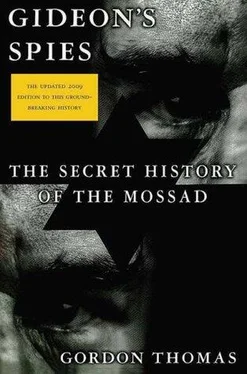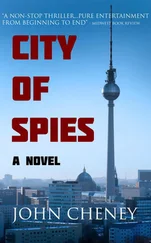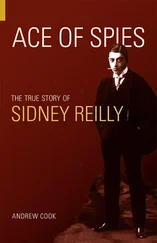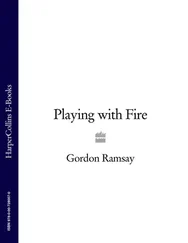Gordon Thomas - Gideon's Spies
Здесь есть возможность читать онлайн «Gordon Thomas - Gideon's Spies» весь текст электронной книги совершенно бесплатно (целиком полную версию без сокращений). В некоторых случаях можно слушать аудио, скачать через торрент в формате fb2 и присутствует краткое содержание. Город: New York, Год выпуска: 2009, ISBN: 2009, Издательство: Thomas Dunne Books, Жанр: История, на английском языке. Описание произведения, (предисловие) а так же отзывы посетителей доступны на портале библиотеки ЛибКат.
- Название:Gideon's Spies
- Автор:
- Издательство:Thomas Dunne Books
- Жанр:
- Год:2009
- Город:New York
- ISBN:978-0-312-53901-6
- Рейтинг книги:4 / 5. Голосов: 1
-
Избранное:Добавить в избранное
- Отзывы:
-
Ваша оценка:
- 80
- 1
- 2
- 3
- 4
- 5
Gideon's Spies: краткое содержание, описание и аннотация
Предлагаем к чтению аннотацию, описание, краткое содержание или предисловие (зависит от того, что написал сам автор книги «Gideon's Spies»). Если вы не нашли необходимую информацию о книге — напишите в комментариях, мы постараемся отыскать её.
Gideon’s Spies
Gideon's Spies — читать онлайн бесплатно полную книгу (весь текст) целиком
Ниже представлен текст книги, разбитый по страницам. Система сохранения места последней прочитанной страницы, позволяет с удобством читать онлайн бесплатно книгу «Gideon's Spies», без необходимости каждый раз заново искать на чём Вы остановились. Поставьте закладку, и сможете в любой момент перейти на страницу, на которой закончили чтение.
Интервал:
Закладка:
McCone, unable to contain his anger any longer—“I had not come to debate”—said the CIA had ample evidence that, while the pope pursued his détente with Moscow, Communism was persecuting priests through the Soviet Bloc, Asia, and South America: Pope John realized that was all the more reason to seek a better relationship with the Soviets. Defeated, McCone returned to Washington convinced that Pope John was “softer on Communism than any of his predecessors.”
John’s not unexpected death—he had a rapidly progressing cancer—was greeted with relief by McCone and President Kennedy.
When Montini of Milan became Paul VI in late 1963, Washington relaxed. Two days after his inauguration, the pope received Kennedy in private audience. Outside, McCone strolled through the Vatican gardens like a landowner who had returned home after a long absence.
Paul’s long pontificate was blighted on the personal front by his declining health and, on the international stage, by the Vietnam War. He came to believe that the escalation President Lyndon Johnson had ordered in 1966 was morally wrong and that the Holy See should be given the role of peacemaker. Three months after Richard Nixon came into the Oval Office, he flew to Rome to meet the pope. The president told him he proposed to increase America’s commitment in Vietnam. Once more the CIA found itself out of favor in the Vatican.
All this, Zvi Zamir had learned from his Washington katsa . Now, on this brilliantly sunny morning on January 10, 1973, as he and his two colleagues were driven into the Vatican to check the security arrangements for Golda Meir’s visit, Zamir hoped it would result in Mossad taking the place of the CIA in the Vatican’s long flirtation with the intelligence world.
Waiting for them outside the Apostolic Palace was the head of Vatican security, a tall, pinch-faced man wearing a dark blue suit, the uniform of the Vigili, the Vatican security service. For several hours he had taken them on a tour of the small city-state, checking possible places where an Arab gunman could hide before trying to assassinate Golda Meir. Unknown to the Vatican security chief, Zvi Zamir was also looking for places where Mossad could plant bugging devices once it had established a working relationship with the Holy See. Zamir flew back to Tel Aviv satisfied with the city-state’s security presentations. More important, he believed he had detected a softening in the attitude of the Holy See toward Israel.
Even before Zamir had landed in Israel, details of Golda Meir’s visit were in the hands of Black September, almost certainly leaked by a pro-Arab priest in the Secretariat of State. For Ali Hassan Salameh, the group’s leader, though he was on the run from Mossad after masterminding the Munich atrocity, Golda Meir’s visit was an opportunity he could not ignore. He began to plan a missile attack against her plane as it landed at Rome’s Leonardo Da Vinci Airport. He hoped to kill not only her, but key government ministers who would be accompanying the prime minister and the senior Mossad men who would also be on board. By the time Israel had recovered from these blows, Salameh hoped, he and his men would be ensconced in the hideout they were negotiating with the Russians to provide.
Since 1968, when a generation born after World War II launched its own war on society—under such disparate names as Italy’s Red Brigades, Germany’s Red Army Faction, the Turkish People’s Liberation Army, Spain’s ETA, and the PLO—the Kremlin had recognized their value in helping to destroy imperialism—and Israel.
Arab terrorists had struck a special chord with the KGB: they were more daring and more successful than most other groups. And they faced a most powerful enemy, Mossad, long a service the KGB both loathed and admired for its sheer ruthlessness. The KGB arranged for selected Arab activists to receive training at the Patrice Lumumba University in Moscow. This was no ordinary campus, but a finishing school for terrorists. They received not only political indoctrination, but also instruction in the latest KGB terrorism target selection and assassination techniques. It was at Patrice Lumumba that Salameh put together the finishing touches to the Munich massacre. After the murderous attack, the surviving members of the group asked Russia to give them sanctuary. But the Soviets were reluctant to do so: the firestorm of fury the Munich attack had generated had made even the Kremlin unwilling to be discovered shielding the killers. They had told Salameh his request for asylum for himself and his men was still being considered.
Nevertheless, the Russians had done nothing to cooperate in the hunt for Black September—and certainly had not revealed that the group had a cache of Soviet missiles hidden in Yugoslavia. These rockets would be used to shoot down Golda Meir’s aircraft.
The plan, like all those created by Salameh, was bold and simple. The missiles would be loaded onto a boat at Dubrovnik and taken across the Adriatic to Bari on Italy’s east coast. From there they would be brought by road into Rome shortly before Golda Meir’s plane arrived. Salameh had also not forgotten the lessons on strategy his KGB instructor at Patrice Lumumba had given: Always make the enemy look the other way. Salameh needed to direct Mossad’s vigilance away from Rome in the run-up to the attack.
On December 28, 1972, a Black September unit attacked the Israeli embassy in Bangkok. The PLO flag was hoisted over the building and six Israelis were taken hostage. Soon five hundred Thai police and troops surrounded the building. The terrorists demanded that Israel release thirty-six PLO prisoners, or they would kill the hostages.
In Tel Aviv, a familiar scenario unfolded. The cabinet met in emergency session. There was the usual talk of standing tough or surrendering. It was left to Zvi Zamir to say that getting to Bangkok would require logistical support that was simply not there along a hostile route. And the Israeli embassy was in the center of busy Bangkok. The Thai government would never allow even the possibility of a shoot-out to occur. Then, after only brief negotiations, the terrorists unexpectedly agreed to a Thai offer of safe conduct out of the country in return for freeing the hostages. Hours later the Black September unit were on a flight to Cairo, where they disappeared.
In Tel Aviv, Zamir’s relief that no Israelis had died turned to suspicion. Black September were highly trained and motivated and well financed, and had shown they had strategic cunning. They understood the methods and pressure points to bring any government to its knees. So why had they given in so quickly this time? The Bangkok embassy was a perfect target to gain them further publicity and so attract others to their cause. Almost certainly there was nothing random in their choice of target. Everything the group did was part of its concentrated assault on democracy. Within the embassy’s compound the terrorists had followed the advice of their guru, Che Guevara, to keep hatred alive. The helpless hostages had been subjected to a tirade of anti-Semitic abuse—but was it all a diversionary tactic? Was another operation somewhere in the world being planned against Israel? Where and when? Zamir was still pondering these questions when he flew with Golda Meir to the Paris conference. From there he continued to search for answers.
In the early hours of January 14, 1973, the break came. A sayan working in Rome’s central telephone exchange handled two telephone calls from a pay phone in an apartment block where PLO terrorists sometimes stayed. The first was to Bari, the second to Ostia, the port that served Rome. The calls were made in Arabic, a language the sayan spoke. The caller said that it was time “to deliver the birthday candles for the celebration.”
Читать дальшеИнтервал:
Закладка:
Похожие книги на «Gideon's Spies»
Представляем Вашему вниманию похожие книги на «Gideon's Spies» списком для выбора. Мы отобрали схожую по названию и смыслу литературу в надежде предоставить читателям больше вариантов отыскать новые, интересные, ещё непрочитанные произведения.
Обсуждение, отзывы о книге «Gideon's Spies» и просто собственные мнения читателей. Оставьте ваши комментарии, напишите, что Вы думаете о произведении, его смысле или главных героях. Укажите что конкретно понравилось, а что нет, и почему Вы так считаете.












